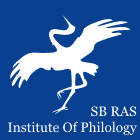 |
|
||||||||||||
|
Institute of Philology of
the Siberian Branch of Russian Academy of Sciences |
|
||||||||||||
|
|||||||||||||
| Sibirskii Filologicheskii Zhurnal (Siberian Journal of Philology) | |
|
Article
Authors: Brodsky I. V. The A. Herzen State Pedagogical University of Russia, St. Petersburg, Russian Federation In the section Linguistics
Abstract: The paper discusses the folk names of guelder rose (Viburnum) in the Finno-Ugric languages, with more than a hundred phytonyms having been studied to reveal their origin, areal distribu-tion, and the lexical nomination of Viburnum according to various features. Among the phytonyms studied, the Baltic-Finnish vocabulary noticeably prevails, probably due to the fact that the dialectal lexical material of Baltic-Finnish languages has been much better collected. The entire study was done from a comparative perspective. The majority of the Finno-Ugric names of guelder rose originated in separate languages and has no correspondences in the related tongues. Not more than two phytonyms belong to the ancient lexical fund. Moreover, in the languages under consideration, there are several names of guelder rose that were borrowed from Germanic, Turkic, and Slavic languages. The compound phytonyms formed in individual languages are numerous and rather diverse. The multiplicity of names given to guelder rose is more characteristic of herbaceous plants, with trees usually having far fewer names with more ancient origin. The Finno-Ugric names of guelder rose are based on a number of features, such as medicinal use, flower coloring, place of growth, and external similarity to other plants. The study has identified the lexical-semantic models by which the compound names of guelder rose were formed, with their components analyzed. Thus, each phytonym may contain two or three components. The names of guelder rose also include zoosemisms denoting various animals: a dog, a wolf, a pig, a partridge, and a crane. Keywords: Finno-Ugric languages, lexics, phytonyms, plant names, lexical nomination, guelder rose Bibliography: Dénes A., Papp N., Babai D., Czúcz B., Molnár Zs. Ehető, vadon termő növények és felhasználásuk a Kárpát-medencében élő magyarok körében néprajzi és etnobotanikai kutatások alapján. Dunántúli Dolgozatok (A) Természettudományi Sorozat (Pécs). 2013, Sz. 13, pp. 35–76. Dmitrieva L. V. Nazvaniya rasteniy v tyurkskikh i drugikh altayskikh yazykakh [Names of plants in Turkic and other Altaic languages]. In: Ocherki sravnitel’noy leksikologii altayskikh yazykov [Essays on comparative lexicology of Altaic languages]. V. I. Tsintsius (Ed. in Ch.). Leningrad, Nauka, 1972, pp. 151–223. Kolosova V., Belichenko O., Rodionova A., Melnikov D., Soukand R. Foraging in Boreal Forest: Wild Food Plants of the Republic of Karelia, NW Russia. Foods. 2020, no. 9, pp. 1015. Koppaleva Yu. E. Finskaya narodnaya leksika flory [Finnish folk lexicon of flora]. Petrozavodsk, KarNC RAS Publ., 2007, 287 p. Lobanova A. S.Etnokonnotirovannaya leksika komi-permyackogo yazyka (na materiale naimenovanij flory) [Ethno-connotated vocabulary of the Komi Permyak language (based on the material of the names of the flora)]. In: Yazykovye kontakty narodov Povolzh’ya i Urala: Sb. st. 11 Mezhdunar. simp. [Linguistic contacts between the peoples of the Volga region and the Urals. Coll. art. from the 11th Intern. Symposium]. A. M. Ivanova, E. V. Fomin (Eds). Cheboksary, Chuvash University Publ., 2018, pp. 124 –127. Vinokurova I. Yu. Zhivotnye v traditsionnom mirovozzrenii vepsov [Animals in the traditional Veps worldview]. Petrozavodsk, PetrSU Publ., 2006, 448 p. |
 |
Institute of Philology Nikolaeva st., 8, Novosibirsk, 630090, Russian Federation +7-383-330-15-18, ifl@philology.nsc.ru |
© Institute of Philology |


